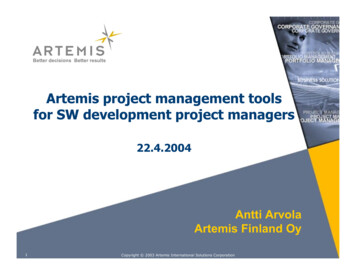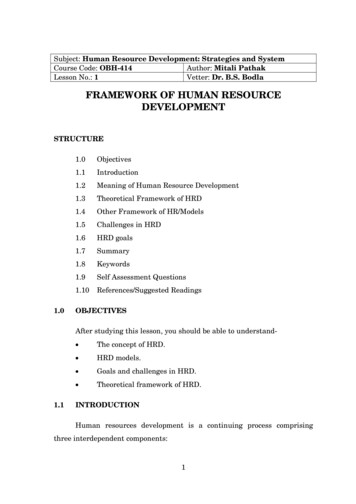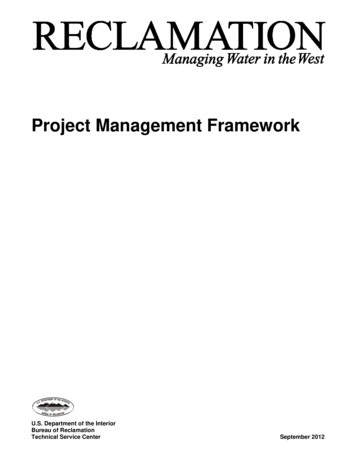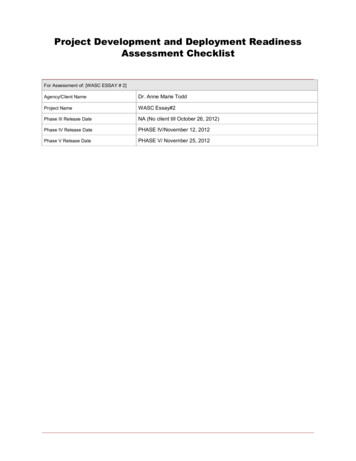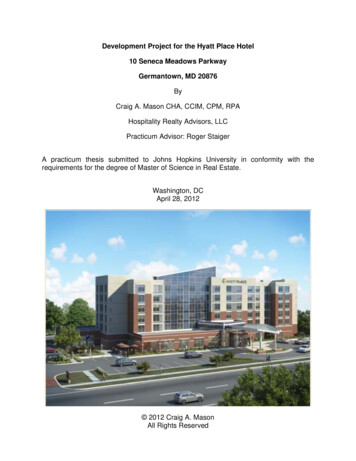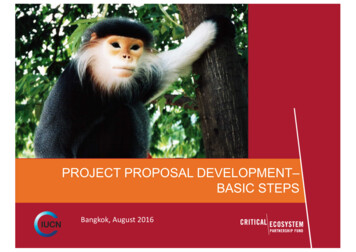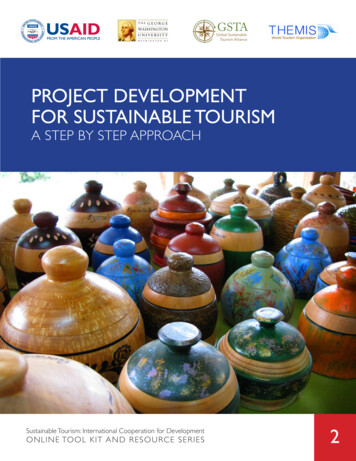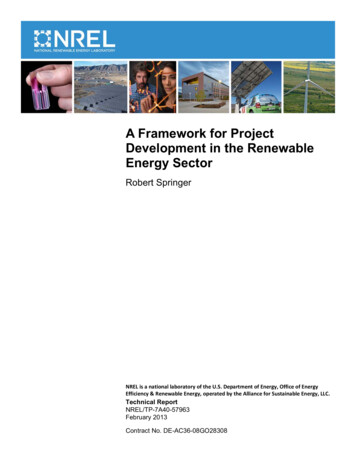
Transcription
A Framework for ProjectDevelopment in the RenewableEnergy SectorRobert SpringerNREL is a national laboratory of the U.S. Department of Energy, Office of EnergyEfficiency & Renewable Energy, operated by the Alliance for Sustainable Energy, LLC.Technical ReportNREL/TP-7A40-57963February 2013Contract No. DE-AC36-08GO28308
A Framework for ProjectDevelopment in the RenewableEnergy SectorRobert SpringerPrepared under Task No(s). 2900.3014 and WFC5.1000NREL is a national laboratory of the U.S. Department of Energy, Office of EnergyEfficiency & Renewable Energy, operated by the Alliance for Sustainable Energy, LLC.National Renewable Energy Laboratory15013 Denver West ParkwayGolden, Colorado 80401303-275-3000 www.nrel.govTechnical ReportNREL/TP-7A40-57963February 2013Contract No. DE-AC36-08GO28308
NOTICEThis report was prepared as an account of work sponsored by an agency of the United States government.Neither the United States government nor any agency thereof, nor any of their employees, makes any warranty,express or implied, or assumes any legal liability or responsibility for the accuracy, completeness, or usefulness ofany information, apparatus, product, or process disclosed, or represents that its use would not infringe privatelyowned rights. Reference herein to any specific commercial product, process, or service by trade name,trademark, manufacturer, or otherwise does not necessarily constitute or imply its endorsement, recommendation,or favoring by the United States government or any agency thereof. The views and opinions of authors expressedherein do not necessarily state or reflect those of the United States government or any agency thereof.Available electronically at http://www.osti.gov/bridgeAvailable for a processing fee to U.S. Department of Energyand its contractors, in paper, from:U.S. Department of EnergyOffice of Scientific and Technical InformationP.O. Box 62Oak Ridge, TN 37831-0062phone: 865.576.8401fax: 865.576.5728email: mailto:reports@adonis.osti.govAvailable for sale to the public, in paper, from:U.S. Department of CommerceNational Technical Information Service5285 Port Royal RoadSpringfield, VA 22161phone: 800.553.6847fax: 703.605.6900email: orders@ntis.fedworld.govonline ordering: http://www.ntis.gov/help/ordermethods.aspxCover Photos: (left to right) PIX 16416, PIX 17423, PIX 16560, PIX 17613, PIX 17436, PIX 17721Printed on paper containing at least 50% wastepaper, including 10% post consumer waste.
Acronyms and AbbreviationsBEPTCBaseline, Economics, Policy, Technology, ConsensusCODcommercial operation dateFCfinancial closeNEPANational Environmental Policy ActNPVnet present valueNRELNational Renewable Energy LaboratoryPPApower purchase agreementRFPrequest for proposalSROPTTCSite, Resource, Off-take, Permits, Technology, Team, Capitaliv
Table of ContentsAcronyms and Abbreviations . ivList of Figures . viExecutive Summary . vii1 Introduction . 12 Key Project Development Concepts . 2342.1 Concept #1: Project Motivation . 22.1.1Pre-development . 22.1.2Establishing Project Motivation with BEPTC . 32.2 Concept #2: Project Development Framework . 52.2.1Seven Essential Elements of Project Development—SROPTTC . 62.2.2Project Development Environment . 72.2.3Iterative Approach/Incremental Investment . 9Process: Applying BEPTC and SROPTTC . 123.1 Further Assumptions . 123.2 Defining the Role of Project Host or Sponsor . 12Generic Example of BEPTC and SROPTTC Framework and Process Approach . 14v
List of FiguresFigure 1. General iterative process concept in project development . 5Figure 2. Three phases of project lifetime and corresponding milestones . 8Figure 3. Project stages with risks and unknowns . 8Figure 4. Iterations of SROPTTC framework in the development stage . 10Figure 5. Iterations of SROPTTC framework and incremental investment decisions . 11Figure 6. BEPTC, SROPTTC, and development phases . 13Figure 7. BEPTC and SROPPTC process diagram with 10 steps . 14vi
Executive SummaryThe development of renewable energy generation projects has become attractive to a variety ofenergy consumers, installations and large institutions, land and real estate owners, and others(collectively referred to herein as the project "sponsor" or "host") who recognize the economic,environmental, and/or security potential of renewable energy. Whether the aspiration is forprojects large or small, and regardless of whether the host will ultimately finance and build theproject themselves, each will find it necessary to take on the role of project developer during theearly stages of project development.The size and diversity of potential project sponsors is significant, including but not limited to, thefederal government and the military (including all its agencies and departments, facilities andinstallations); public and private universities and colleges; local and state governments; tribalnations; private and public companies from sole proprietorships to Fortune 500 companies; realestate investment trusts to private individuals; nonprofits and nongovernment organizations. It israre to have resident professional energy project development experience within the vastmajority of these new market participants—many of whom have largely dealt with electricalenergy by simply "paying the bill," and now are motivated to consider the relatively radicalchange of "producing their own," or at least participating in a project in some meaningful way.The concepts, descriptions, diagrams, and acronyms developed and described herein are meant toprovide a contextual framework as well as a systematic, repeatable process to assist a potentialproject sponsor in understanding and navigating early-stage project development. Professionalproject developers will recognize these concepts and hold them as intuitive and even obvious,though the fundamentals of this specialized field are rarely written down and defined as they arehere.Project development is primarily viewed as an entrepreneurial activity, subject to significantrisks and unknowns while requiring ongoing investment of time, financial, and even politicalresources toward output that consists of completedprojects.Prior to embarking on thespecifics of any particularPrior to embarking on the specifics of any particularproject, it is essential to gaugeproject, it is essential to gauge the fundamental marketthe fundamental marketcharacteristics that create the conditions for success andcharacteristics that create theprovide sufficient support to generate what we callconditions for success and"project motivation." A motivated project is one that hasprovide sufficient support toa clear pathway to success and enough opportunity that itgenerate what we call "projectsimply cannot be ignored. It is driven by some baselinemotivation."need or interest in completing the project, the fundamentaleconomics of energy in the area, existing policy environment (both internal and external to theproject sponsor), and available commercial technologies and renewable resource. Thisassessment and communication of fundamental project motivation is referred to using theacronym "BEPTCTM" for Baseline, Economics, Policy, Technology, and Consensus. 1 Consensuswith project stakeholders is ideally built around the four previous characteristics.1BEPTC is a trademark of the Alliance for Sustainable Energy, LLC, the operator of NREL.vii
With project motivation clearly established and communicated using the BEPTC framework, onecan seriously approach a specific project with purpose and confidence that the first incrementalinvestment in the project (in time, financial or political capital, etc.) is worthwhile. It isimmediately clear that all expenditures are subject to the riskTo manage development risk,of complete loss, and this risk must be recognized andfatal flaws absolutely need to bemanaged. In response, a key tenet of early-stageidentified and analyzed quicklydevelopment is fatal flaw analysis. To manage developmentand accurately to avoidrisk, fatal flaws absolutely need to be identified andinvestment of scarce risk capitalanalyzed quickly and accurately to avoid investment ofinto "bad projects" and toscarce risk capital into "bad projects" and to conserve theseconserve these resources.resources. This concept shapes the process of moving adevelopment project forward.Project development now begins in earnest; it is essential to have a clear understanding of theoverall context and operating environment, a framework with which to organize and interpretinformation, an iterative process and fatal flaw analysis that mitigates risk while incrementallymoving the project forward, and tools that support and inform decisions, monitor projectmotivation, and do so in a regular, repeatable, disciplined manner.NREL has defined the seven core subject areas of renewable projects to be: Site, Resource, Offtake, Permits, Technology, Team, and Capital—and describe each in more depth in the sectionsthat follow. These core areas form the informational framework, and are the source of theacronym "SROPTTCTM," which has come to represent collectively all of the environment,framework, processes, and tools of project development. 2The principles and concepts represented by BEPTC and SROPTTC in their entirety are universalto the project development process and essential in successfully managing development risk.2SROPTTC is a trademark of the Alliance for Sustainable Energy, LLC, the operator of NREL.viii
1 IntroductionTo establish a common understanding and language around the fundamental principles of projectdevelopment two concepts need to be developed—project motivation and the projectdevelopment environment. This report details each of these concepts by using the NationalRenewable Energy Laboratory (NREL)-developed BEPTC and SROPTTC frameworks tohighlight and support the predevelopment and development processes and activities eachrenewable energy project should undergo.The author is writing this for primary use by an employee or decision-maker in a project host orsponsor role who is considering the pursuit of an on-site renewable energy project of somesignificant scale. While larger-scale renewable project development is most obviously in need ofan intensive development management scheme, the general principles and practices areapplicable on projects of any size.The first concept is project motivation—a motivated project is one that has a strong basis tocome to fruition and is built on economics and risks that are acceptable to all parties; supportivepolicies and an execution pathway; and project “bankability.” The five essential areas for strongproject motivation—Baseline, Economics, Policy, Technology, and Consensus—are referred toas BEPTC.The second concept is developing a contextual framework and mapping an established,repeatable, disciplined process for project development that is consistent with professionalcommercial practices. The seven essential areas for strong project development—Site, Resource,Off-take, Permits, Technology, Team, and Capital—are referred to as SROPTTC.Section 2 details each of the key concepts of project motivation and project development in moredetail.With the general concepts of project motivation and project development introduced, projecthosts and/or sponsors need to take the time to consider the concepts in action and begin thinkingabout how to apply them. Section 3 provides details and examples for applying the BEPTC andSROPTTC concepts.1
2 Key Project Development ConceptsThe two major concepts to establish a common understanding and language around thefundamental principles of project development are project motivation and the projectdevelopment environment.A motivated project is one that has a strong basis to come to fruition and is built on economicsand risks that are acceptable to both parties, and includes supportive policies, an executionpathway, and project “bankability.”The second concept is a framework and mapping of an established, repeatable, disciplinedprocess for project development that is consistent with professional commercial practices. Theseconcepts are discussed below in greate
Project development now begins in earnest; it is essential to have a clear understanding of the overall context and operating environment, a framework with which to organize and interpret information, an iterative process and fatal flaw analysis that mitigates risk while incrementally moving the project forward, and tools that support and inform decisions, monitor project motivation, and do so .
